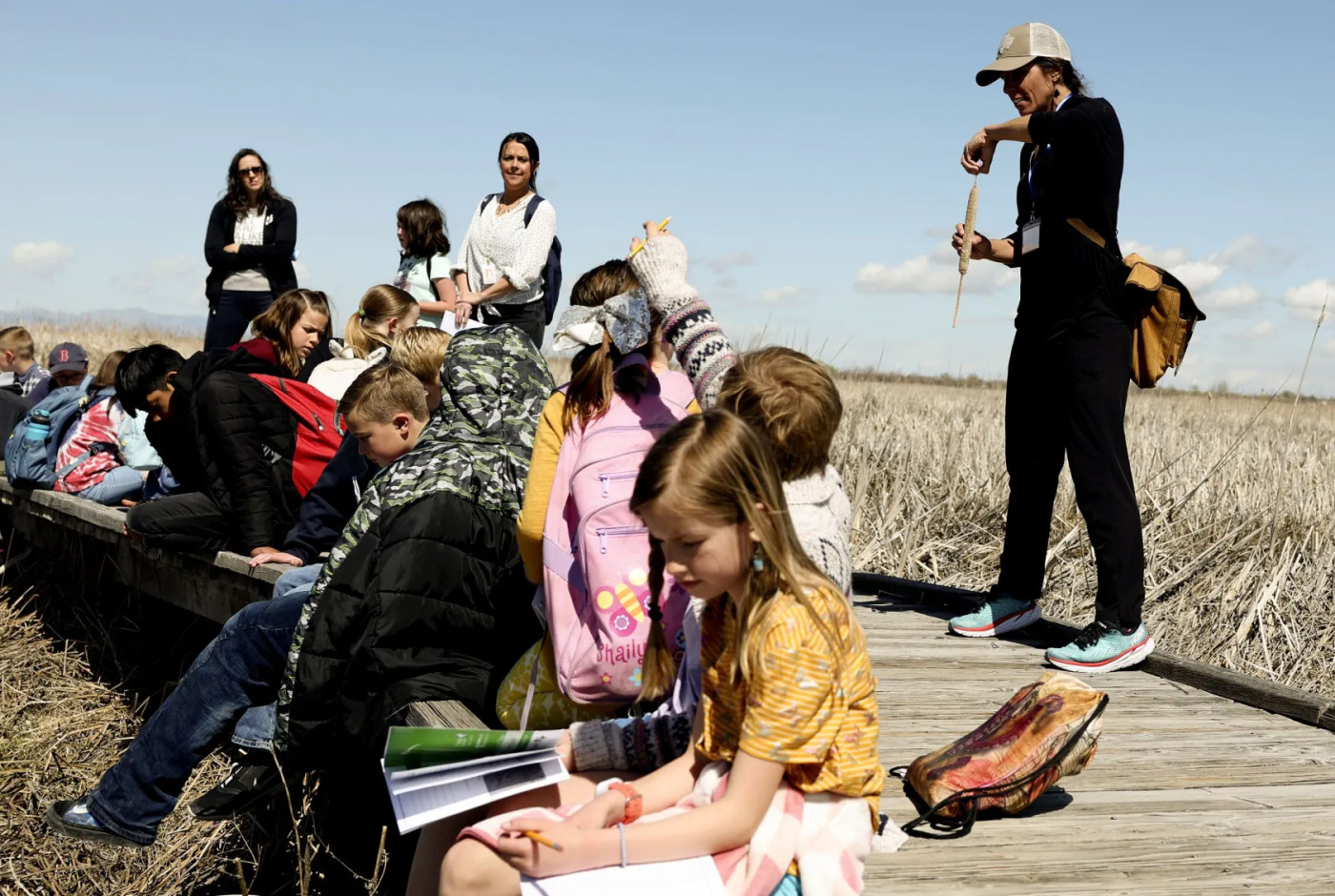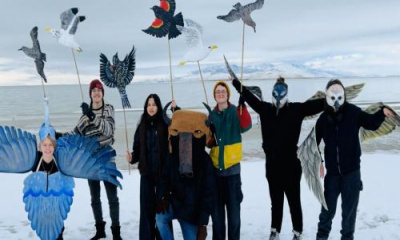Studies show link between youth education, protecting nature
To save the Great Salt Lake is to know its worth. To know its worth is to be educated about why it matters.
For 16 years, The Nature Conservancy has introduced the value of the Great Salt Lake and its vast wetlands and uplands to 22,000 fourth graders from six school districts.
Called Wings & Water, the program is among many educational outreach efforts offered by varying groups to get youth acquainted with the unique ecological features offered by the largest saline lake in the Western Hemisphere and the eighth largest in the world.
“Wings & Water is one way to get those students out there to create a relationship with the lake. I do think these students revisit and have a sense of place with the Great Salt Lake,” said Andrea Nelson, community outreach coordinator with The Nature Conservancy.
This week marks the official return of the program after a two-year hiatus caused by the COVID-19 pandemic.
Education equals enlightenment
A busload of children from Davis County visited Tuesday, and on Wednesday, 80 students from Creekside Elementary were able to explore the marshes and the visitor center at the conservancy’s 4,400-acre Great Salt Lake Shorelands Preserve in west Layton on the eastern shores of the Great Salt Lake.
The lake is shrinking, having reached its historic low last year. More than 800 square miles of lakebed have been exposed and a critical, complex ecosystem is in trouble.
As the lake struggles, so does the industry it supports, the millions of birds that visit, and its economic might of $1.3 billion in annual contributions to Utah’s economy is in jeopardy.
Volunteer naturalist Kristen Bonner, right, shows Creekside Elementary students a cattail at the Great Salt Lake Shorelands Preserve as part of The Nature Conservancy’s Wings & Water program in Layton on Wednesday, April 20, 2022.
Laura Seitz, Deseret News
Nelson said she believes educational outreach programs like Wings & Water leave an ecological imprint on young minds.
“When we take them out on that one-mile boardwalk right in the middle of the wetlands, the frogs are singing and the sandhill cranes are flying over and singing — that is the idea, to build this relationship with the Great Salt Lake and its watersheds.”
Marissa Joann Hardy is young proof of that success.
“I loved seeing all the birds flying and the other stuff living in this habitat,” she said during her visit Wednesday. “I hate that people destroy it. I hate it. I don’t like it. I think you just build a little, keep it half nature and half of what it is now. ... That is what God created.”
She added more people should visit the Great Salt Lake, to learn like she is learning.
“I really think they should see nature and leave it how it is.”
Katharine Hayhoe, The Nature Conservancy’s chief scientist and the United Nations selection as the U.N. Champion of the Earth in 2019, visited the preserve Wednesday with the schoolchildren.
She told the Deseret News it is critical to get people, especially young people, tuned into nature.
Students from Creekside Elementary explore the marshes at the Great Salt Lake Shorelands Preserve as part of The Nature Conservancy’s Wings & Water program in Layton on Wednesday, April 20, 2022.
Laura Seitz, Deseret News
The intersection of nature and people
“It’s very important because we are all part of nature. All too often we like to think of ourselves as separate, like there is nature and then there are humans. But where does the air that we breathe come from? Where does the water we drink come from? Where does the food that we eat come from? Where does everything we use to make everything we have come from?” Hayhoe said.
“It is important to recognize that our health depends on the health of the planet.”
She said that too often, climate change, saving for retirement or even having the right diet and exercising like we should are issues that people put at a psychological distance — to think about later. Or, they think climate change is happening over there, not here.
“But when we see things like the Great Salt Lake drying up right in front of our eyes, it’s no longer over there, it’s here. It’s no longer in the future.”
She said children, when exposed to nature, often understand its value much more readily than adults because they lack preconceived notions and the layers of culture and ideology that develop over time.
“Kids understand that intuitively, this is important, that it matters.”
A sense of place
Carla Trentelman did her dissertation on the Great Salt Lake derived from input more than 400 research participants in Davis and Weber counties.
“Overall, the folks who had the most experience and the most involvement with the lake also had the most attachment with the lake, feeling that it was a place that needed to be protected, a place they wanted to spend time with.”
Trentelman, a professor of sociology at Ogden’s Weber State University, said she absolutely believes that early experiences with the lake will help guide solutions to its troubling condition.
“In the research that stood out, the more involvement participants had as kids, the stronger their connections were with the lake,” she said. “People’s eyes, when they tell stories about wandering the Great Salt Lake area, the wetlands, the shoreline, getting in the water, that whole complex, their eyes would get a sparkle in them and you could tell how important that was.”
The disconnect with tech
But getting out in nature is happening less frequently for the generations hooked on screen time.
Florence Williams, author of “The Nature Fix,” explored the physical, social and mental benefits from spending time outdoors — research inspired by her own move to Washington, D.C., from Colorado.
“I was blown away by the human noise,” she recalled in an interview in 2020, adding the metropolitan area was like an urban moonscape with no children playing outside.
Her findings underscore the need to connect children, especially, with the outdoors and the great value it provides not only for personal well-being but increased awareness and appreciation for the places they visit.
Unfortunately, she said her research revealed that American children spend about half as much time outdoors as their parents did.
She pointed out one survey that noted 72 percent of a group of mothers responded they went outside every day as children. Yet among that same group of mothers, only 26 percent said their children get that same experience.
‘Follow the science’
Research around the globe, however, underscores the value of getting that connection to nature and how it develops those protective attitudes.
A study published in the Journal of Environmental Psychology in 2019 explored the potential benefits of a four-hour nature experience on children’s mood, pro-sociality and attitudes toward nature. Eighty students from an urban Canadian elementary school were recruited to participate in field trips to a nature school and an aviation/space museum.
The Ottawa-based Carleton University research found children reported more positive and negative emotions, a closer connection to nature and a greater willingness to protect nature when at the nature school.
Another study led by German researchers looked at the cultural background of refugees based on seven distinct geographic regions who were attending German schools to determine if culture had an impact on their connection to nature.
They found that the cultural background of students did not impact what they called “Inclusion of Nature in Self” but time spent in forests did, boosting that connectivity.
Constraints of education
But The Nature Conservancy’s Wings & Water program is not without its limitations, and it is not the panacea for the Great Salt Lake. It is a step.
The global organization only has the money to reach a certain number of fourth graders in two time-sensitive windows of the year — in April and May and September and October — for visits to the Great Salt Lake.
The organization relies on a lot of fundraising with its partner, the Utah State University Botanical Gardens, and it simply does not have enough staff.
It is among many organizations, such as Friends of the Great Salt Lake and the Natural History Museum of Utah, working in this realm of education.
“These places have complicated and dynamic ecosystems that deserve our awareness. The Great Salt Lake is having a really hard time,” Nelson said.
The other obstacle? It is going to take years for these children to grow up and help chart the destiny of the Great Salt Lake, which is flailing now. Is there enough time?
She hopes so.
“Kids who live along the Wasatch Front who have a relationship to the Great Salt Lake, some of them will end up being our water managers, ecologists and scientists. That’s important.”







